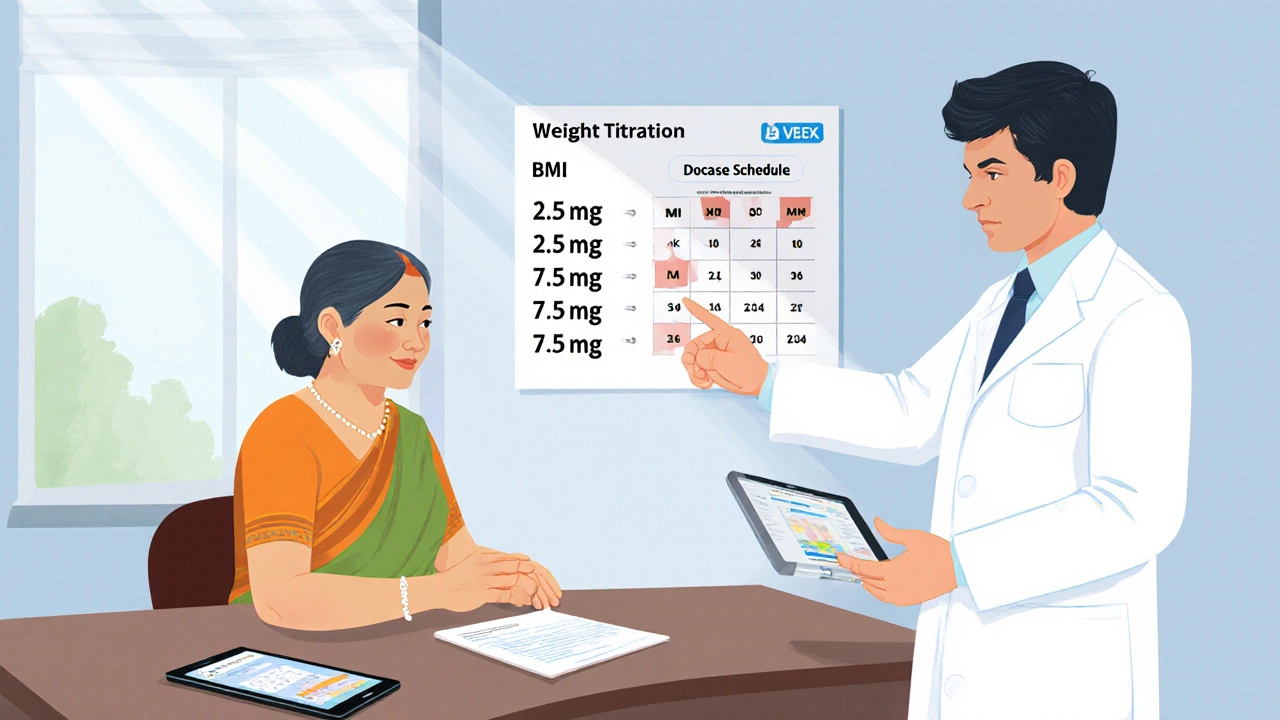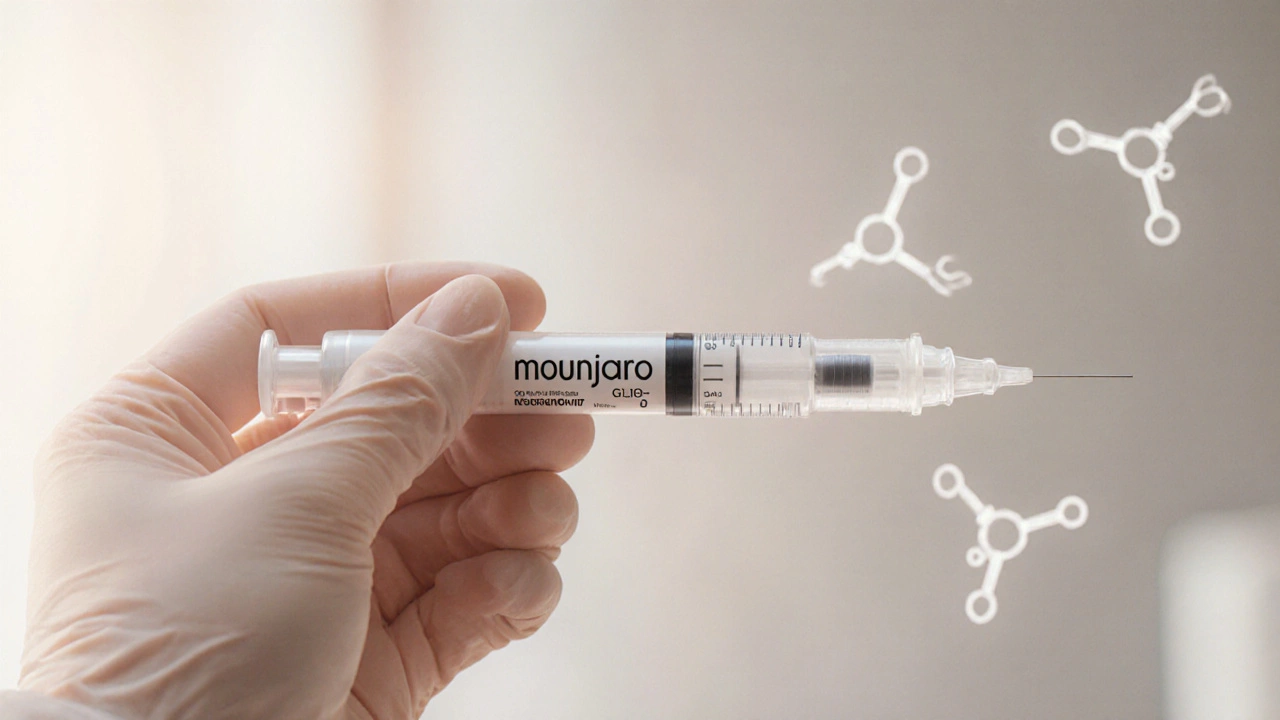Mounjaro Weight Loss Estimator
Calculate Your Potential Weight Loss
Based on clinical study data and real-world experience. Results may vary based on individual response and lifestyle factors.
Your Estimated Results
Potential Weight Loss
Based on clinical studies (average 68-week results)
Key Factors
How This Compares
| Drug | Average Weight Loss | Main Side Effects |
|---|---|---|
| Mounjaro | ≈ 15% | Nausea, vomiting, diarrhea |
| Wegovy | ≈ 15-17% | Nausea, constipation, abdominal pain |
| Ozempic | ≈ 10% | Nausea, dyspepsia, injection site reactions |
Important Notes
Mounjaro requires prescription and medical supervision. Results depend on individual response, adherence to medication schedule, and lifestyle changes. This estimate is based on average clinical trial data and may not reflect your personal outcome.
Key Takeaways
- Mounjaro (tirzepatide) is approved for type 2 diabetes but is increasingly used off‑label for obesity.
- Doctors can prescribe it for weight loss if the patient meets specific BMI and health criteria.
- Typical dosing starts low and ramps up weekly; side‑effects are mostly gastrointestinal.
- Compared with other injectables like Wegovy and Ozempic, Mounjaro shows slightly greater average weight loss in trials.
- In India, prescription follows the Drug and Cosmetics Act and requires a qualified physician.
What is Mounjaro?
Mounjaro is the brand name for tirzepatide, a dual GIP and GLP‑1 receptor agonist developed by Eli Lilly for managing type 2 diabetes. It entered the market in 2022 and quickly attracted attention because clinical studies reported substantial weight loss alongside blood‑sugar control.
How does Mounjaro work for weight loss?
The drug mimics two gut hormones: glucose‑dependent insulinotropic polypeptide (GIP) and glucagon‑like peptide‑1 (GLP‑1). By activating both pathways, it reduces appetite, slows gastric emptying, and improves insulin sensitivity. In practice, patients often report feeling full after smaller meals, which translates into fewer calories consumed each day.

Prescription guidelines: Who can get it?
Although Mounjaro is officially approved for diabetes, many endocrinologists prescribe it for obesity under the ‘off‑label’ umbrella. The typical criteria used in weight‑loss clinics are:
- BMI≥30kg/m², or BMI≥27kg/m² with at least one obesity‑related condition (e.g., hypertension, sleep apnea).
- Documented attempts at lifestyle modification that failed to achieve ≥5% body‑weight loss.
- No contraindications such as medullary thyroid carcinoma or multiple endocrine neoplasia type2.
In India, the Drug Controller General of India (DCGI) follows the same safety profile, and a licensed physician must write the prescription.
Dosing and administration
Patients start with a 2.5mg weekly sub‑cutaneous injection, increasing by 2.5mg every four weeks until reaching the target dose (usually 10mg, 12.5mg, or 15mg). The titration schedule helps mitigate nausea and vomiting, the most common side‑effects.
- Week1‑4: 2.5mg
- Week5‑8: 5mg
- Week9‑12: 7.5mg (optional)
- Week13 onward: 10‑15mg based on response and tolerance
Patients inject into the abdomen, thigh, or upper arm. A prefilled pen eliminates the need for a separate syringe.
Comparison with other weight‑loss injectables
| Drug | Active ingredient | Approved use | Average % weight loss | Main side‑effects |
|---|---|---|---|---|
| Mounjaro | Tirzepatide | Type 2 diabetes (off‑label obesity) | ≈15% | Nausea, vomiting, diarrhea |
| Wegovy | Semaglutide | Obesity treatment | ≈15‑17% | Nausea, constipation, abdominal pain |
| Ozempic | Semaglutide | Type 2 diabetes | ≈10% | Nausea, dyspepsia, injection site reactions |
All three drugs share a GLP‑1 mechanism, but Mounjaro’s added GIP activity appears to give a slight edge in early weight‑loss numbers. Individual response varies, so clinicians tailor the choice to patient history.
Benefits and risks
Key benefits include:
- Significant reduction in body weight without drastic calorie restriction.
- Improved glycemic control for patients with diabetes.
- Potential reduction in cardiovascular risk factors (blood pressure, triglycerides).
Principal risks to discuss with a doctor:
- Gastrointestinal upset - usually resolves with dose titration.
- Pancreatitis - rare but serious; patients should stop the drug and seek care if severe abdominal pain occurs.
- Thyroid C‑cell tumors - a contraindication based on animal studies; doctors screen for personal/family history.
Because the medication is injectable, proper storage (refrigeration) and handling are essential.
Real‑world experience in Indian weight‑loss clinics
City‑center clinics in Pune, Mumbai, and Delhi report that patients who stay on Mounjaro for at least six months lose an average of 12‑14% of their initial weight. Success rates climb when the drug is combined with a structured diet plan (around 1,200‑1,500kcal/day) and supervised exercise.
One clinic administrator shared a case: a 42‑year‑old woman with BMI33kg/m² and uncontrolled hypertension lost 18kg in five months, and her blood pressure dropped from 150/95mmHg to 128/82mmHg without adding antihypertensive medication.
Cost remains a barrier; a 4‑week supply of Mounjaro can cost INR18,000‑20,000, and insurance coverage is limited. Some patients opt for monthly installment plans offered by pharmacy partners.
Frequently Asked Questions
Can I use Mounjaro if I don’t have diabetes?
Yes, many doctors prescribe it off‑label for obesity when BMI criteria are met and other weight‑loss methods have failed. The decision rests on a risk‑benefit assessment.
How quickly will I see weight loss?
Most patients notice a 2‑5% reduction in the first 8‑12weeks, with the curve steepening as the dose is increased.
Do I need to continue the injection forever?
Long‑term therapy is common because stopping often leads to weight regain. Some clinicians taper the dose after a year if weight‑maintenance is stable.
Are there any drug interactions?
Mounjaro can slow gastric emptying, so oral medications that require rapid absorption (e.g., certain antibiotics) may need timing adjustments.
What monitoring is required?
Baseline labs (HbA1c, liver enzymes, lipase) and regular follow‑ups every 4‑6weeks during titration help catch side‑effects early.
If you’re considering Mounjaro, schedule a consultation with a certified endocrinologist or a weight‑loss clinic that has experience with injectable therapies. A personalized plan, realistic expectations, and regular monitoring are the keys to turning the medication into lasting results.





